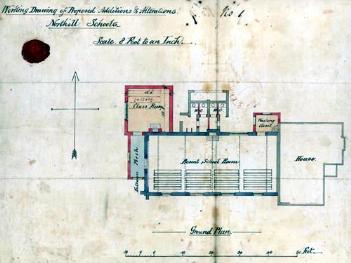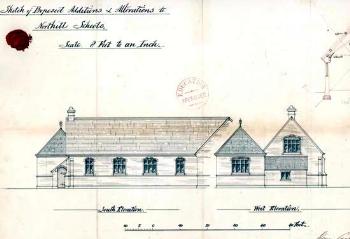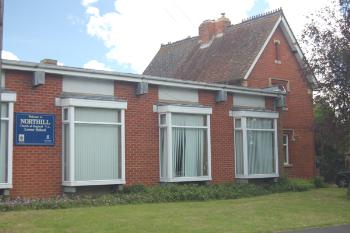Education in Northill

National School rules [P10/29/1/1]
Early Education
The earliest mention of education in Northill in any records held at Bedfordshire & Luton Archives & Records Service is in 1689 when the Overseers of the Poor were acting for the children of deceased pauper Richard Jennings - a receipt includes payment for their education [P10/18/12]. In the next century there are a number of references in churchwardens' accounts to a school in the parish, probably in a room over the porch [P10/5/2-4] - which may be either a daily or a Sunday School: in 1708 there is a sum for: "mending the School stairs"; in 1780 one for "lime for the Schoolroom"; and in 1800 one for a "lock for the schoolroom door".
There is also a reference to schooling in Northill in the archives of the Archdeaconry of Bedford. In 1710 a glebe terrier [ABEII] notes: "The Schoolmaster is John Baker who lives at warden and hath a Salary by subscriptions of the Gentry in the Parish to teach poor children of this parish". Further references occur in the parish registers including: Isaac Carter, schoolmaster, buried 28 Apr 1755 and Joseph Lancaster, cordwainer, parish clerk, sexton and schoolmaster buried 6 Oct 1762.
In 1728 a Mrs.Hutchinson died and left £200 to the parish to be used to set up a charity to purchase land and the rents to be used to educate "as many poor and fatherless girls, inhabitants of that parish, as her trustees…should think convenient". The parish archives contain an account book which details payments from various charities [P10/25/26] and the Hutchinson charity used rents from land purchased at Thorncote, the payments in the account book running between 1739 and 1789.
The Bishop of Lincoln carried out visitations to Bedfordshire in 1717 and 1720 and for both of these a list of questions was sent out in advance, one of which enquired about the provision of schools in each parish. The return for Northill in 1717 read: "We have a Charity School maintained by subscription wherein about 18 children (at present) are taught to read and rehearse the Church catechism". The return for 1720 was identical, except that the number of children had reached 20.

Plans of National School [AD3865/32/2]
Early 19th Century Education
In 1818 a Select Committee was established to enquire into educational provision for the poor. This was no doubt prompted, in part, by the recent foundation of two societies promoting education and specifically the building of schools. The Society for Promoting the Lancasterian System for the Education of the Poor was established in 1808 promoting schools run along the lines pioneered by Joseph Lancaster, who had himself copied those of Dr.Andrew Bell, in which older children taught their younger fellows. The Society was renamed the British and Foreign School Society in 1814,. It was supported by a number of prominent nonconformists, Lancaster himself was a Quaker, and sought to teach a non-sectarian curriculum. In answer to this perceived nonconformist takeover of local education the National Society was formed in 1811 to encourage the teaching of poor children along Anglican lines, including the catechism. The Select Committee sent a questionnaire to all parishes in the country asking for: particulars relating to endowments for the education of children; other educational institutions; observations of parish needs etc. The return for Northill recorded, oddly, that no endowment existed for educating children, despite the existence of the Hutchinson charity. This obvious error calls into question the reilability of the survey, perhaps the curate, who filled the questionnaire in, was ignorant of the Charity's existence, or perhaps to thought the parish would receive help if they did nor reveal its existence. The return also recorded the existence of a day school "in which 30 children are instructed at 4d. each, by the parish clerk". The curate ended by saying: "The poor are generally desirous of having their children taught to read, but bein ganxious to benefit by their labour, take them from school at too early a period".
In the country generally the number of schools built continued to grow over the next fifteen years so that by 1833 the government agreed to supplement the work of the two societies, and local benefactors, by making £20,000 per annum available in grants to help build schools. It also prompted another questionnaire to be sent to each parish in England asking for details of local educational provision. The reply from Northill ran as follows: "One Infant School (commenced 1830) in which 18 children of both sexes are instructed. Two Daily Schools, containing 18 boys and 16 girls. One Sunday School of 40 boys and 70 girls; all supported by subscription". In those days a Sunday School was just that, a school which met on a Sunday, usually in the church or nonconformist chapel or other similar building, teaching more than the religious topics with which they are associated today.
The next national enquiry was in 1846/7 when the Church of England made an enquiry as to all its church schools. This was against the background of a new Whig government which championed secular education and the increasing importance of nonconformists, particularly Wesleyan Methodist, and Roman Catholics in providing schools. The Northill return indicated that 40 boys and 82 girls attended Sunday school and a total of 39 boys and 40 girls attended a Dame's School and five other schools.

Elevation of National School [AD3865/32/3]
Northill National School
Northill National School was created in 1855, the site having been acquired four years earlier and the rules are shown above [P10/29/1/1] and logbooks survive from 1863 going through to 1976 [SDNorthill1/1-3]. In 1869 the rector agreed with local builder Henry Field to pull down the existing buildings and build a new school according to accompanying plans [AD3865].
The first Education Act was passed in 1870 (more correctly it was known as the Elementary Education Act). It was a milestone in the provision of education in Britain demonstrating central government's unequivocal support for education of all classes across the country. It also sought to secularise education by allowing the creation of School Boards. These were groups of representatives, elected by the local ratepayers and the Board had the powers to raise funds to form a local rate to support local education, build and run schools, pay the fees of the poorest children, make local school attendance compulsory between the ages of 5 and 13 and could even support local church schools, though in practice they replaced them, turning them into Board run schools (known as Board Schools). Naturally, and luckily for local historians, the Act required a questionnaire of local schools in 1870. The questionnaire for Northill recorded the existing National School with accommodation for 141 children. No School Board was ever formed in Northill, the school remaining a National School until the next great Education Act.
The School log books provide an interesting glimpse of Victorian life in a small village school and the effect of earning a living on school attendance [SDNorthill1/1]:
- 17 Jul 1871: Attendance small, onion peeling began.
- 28 Jun 1872: A fresh sphere of Agriculture opened for young children, viz. hay making. This is the first year children have been thus employed.
- 5 Jul 1872: Children away Turnip threshing.

Northill VA Lower School Jul 2007
20th Century Education
A land mark Education Act was passed in 1902, coming into effect in 1903. It disbanded the School Boards and gave day to day running of education to newly formed Local Education Authorities, usually the county council, as in Bedfordshire. The old Board Schools thus became Council Schools whilst the old National, British and other non-Board schools became known as Public Elementary Schools. Northill National School duly became Northill Public Elementary School.
Bedfordshire & Luton Archives & Records Service has a scrapbook of cuttings of visits made to most Bedfordshire Schools by School Inspectors for a period from just before the First World War through the inter-war years [E/IN1/1]. The first report dates to 1911, when average attendance was 109 and noted: "The older scholars are in good order and their attainments are fairly satisfactory….points requiring attention are the arithmetic of the upper part of the first class, the singing of the same class, the composition and arithmetic of the middle group and the reading of the lowest. The condition of the Infants' Division is, on the whole, fairly satisfactory, but the reading of the First Class leaves a good deal to be desired". In 1913 no changes to the junior department were noted except an improvement in PE, overall it was noted: "The children, especially of those of the lower divisions and of the Infants' Class speak indistinctly".
The first report after the Great War, in 1919, was not encouraging: "A visit on 30th October last [1918], shewed that in certain respects the work of the school was unsatisfactory. Since that date one of the assistant teachers has left. It is creditable that this has not led to a further falling off in the 3 Rs, indeed there is evidence of pains having been taken to rectify defects in the written work that were noticed at the former visit. There is still much to be done to put the work of the Mixed Division on a satisfactory footing. Especially the Physical Exercises, Singing, Drawing and Oral Subjects must be taken in hand. I the Infants' Division, though there is no falling off at present and Reading has improved, it is clear that further assistance is rquired. If this cannot be obtained children under 5 years of age should not be admitted". No great improvement was noted in the next inspection, in 1922.
It was not just the teaching that merited concern. In 1925 the buildings were inspected and the report noted: "Both heating and cloakrooms are inadequate: the boys' washing arrangements are in a shed which is rotting away. the playground surface is rough and the water cannot drain away from it or from the boys' urinal. Both the offices are cesspits at present and should be reconstructed as water closets".
Things at the school remained poor in 1926, the report noting: "The chief characteristic of the School, which is far from inefficient, is want of life and alertness. The lowest group, Infants and Standard I, are working on a Time table which does not provide for Standard I. the Teacher is not clever at keeping all the groups occupied, and they are shy and slow of speech. The top group say recitation without expression or enjoyment, are slow at attempting commonsense sums, and in Physical Training are inclined to stamp when marching; and, as a word of command is not well given, there is not much vigour in the exercises". Even the girls' needlework was sloppy: "The girls were slow in response, and were particularly sloe at reckoning the relative proportions of garments according to any given measure".
In 1927 the parish, including the school buildings, was visited by a valuer and all buildings and land valued in accordance with the 1925 Rating Valuation Act. The valuer found [DV1/C/4] that the Voluntary School was built of brick and tile and was "good"; it had a large class room, small class room, three cloak rooms and a book room, boys' earth closets, girls' earth closets, boys' urinal, washhouse, coal barn and accommodation for about 135. He further noted: "School supported by endowments, grant from Government towards repairs and County Council pays teachers"
However, by the next year things were a little brighter: "The criticisms of the last report on the work of this school, in so far as they refer to matters of organisation, aims and methods, have received attention…A good feature is the very thorough way that the work in all subjects is periodically tested and critical reports made in the record books. A promising start has been made in the new handwork scheme of Light Woodwork for the senior boys and Cardboard work for the juniors. Other possible developments, such as the elaboration of the school scheme, the introduction of private study methods with the seniors and the establishment of a team system, were discussed with the Head Master during the inspection".
The last report is for 1934, when average attendance was down to 43 because "This School has become a Junior School since the date of the last report. It is conducted in two classes, Standards II, III and IV under the Head Mistress, and Standard I and Infants under a Supplementary Teacher. It is understood that the latter had many years experience with children of 3 and 4 years of age; she is exceedingly kind and pelasant, but cannot as yet manage the higher groups…the older children are in much better care than this…The new desks and redecoration of the school have made a great improvement in brightness in the building".
The third of the great Education Acts was that of 1944 which established the principle of County Primary Schools for children up to the age of 11, at which time they took an examination to determine the nature of the secondary school they would attend until they were 15, the most academically able going to grammar schools, the rest to secondary or secondary modern schools. The act also created two types of successor to the public elementary schools - the Voluntary Aided and Voluntary Controlled schools. Voluntary Aided schools are those in which the Local Education Authority funds the school but the governing body is independent. Voluntary Controlled schools own their own buildings whilst the staff are employed directly by the governors. Northill Public Elementary School became Northill VA County Primary School.
In the 1970s Bedfordshire County Council introduced comprehensive education, doing away with the 11+ examination and grammar schools and introducing a tier of school between the old County Primary and County Secondary Schools. Thus Lower Schools now taught children aged 4 to 9, Middle Schools from 9 to 13 and Upper Schools from 13 onwards. Northill school duly became Northill VA Lower School; it continues [as of 2007] to occupy the 1869 buildings near the church, albeit with modern additions.
Sources
Early
- P10/18/12: payment for education of children of Richard Jennings: 1689;
- P10/5/2: "mending the school stairs": 1708;
- ABEII: glebe terrier noting schoolmaster: 1710;
- P10/25/14: a few payments for schooling: 1717-1822;
- P10/25/26: Hutchinson's Charity including payments for schooling: 1739-1789;
- ABT1747/7: burial of wife of Isaac Carter, schoolmaster: 1747;
- ABT1755: burial of Isaac Carter, schoolmaster: 1755;
- Parish register: burial of Joseh Lancaster, sexton and schoolmaster: 1762;
- P10/5/3: lime for the schoolroom: 1780;
- P10/1/8: notes on deed of school site: C19th;
- P10/5/3: lock for the schoolroom door: 1800;
- P10/5/4: Mr.Wing put in a new window: c.1826;
National/Public Elementary/VA County Primary/VA Lower School
- CRT130NOR23: copy enrollment of deed of school site: 1851;
- QDC44: trust deed: 1851;
- SDNorthill1/1-3: school logbooks: 1863-1976;
- P10/29/1/2: agreement to erect school: 1869;
- AD3865/32: plans and alterations to school and master's house: 1869;
- P10/2/5/4: details of contract to build school: c.1869;
- Z773/4/1: notice giving number of pupils in school: 1870;
- P10/29/1/3-14: correspondence, accounts etc. regarding school: 1870-1932;
- P10/29/1/1 and 7: school rules: 1879;
- P10/25/29: papers regarding endowment and donations from charity: c.1879-1950;
- SDNorthill2/1: admission register: 1903-1972;
- P10/25/28: school accounts: 1903-1939;
- E/TE5/3: details of teachers: 1904-1908;
- E/TE5/4: details of teachers: 1908-1912;
- E/IN1/1: inspector's reports: 1911-1934;
- X758/1/12/48: postcard of schoolchildren: c.1920s;
- P10/28/2: school correspondence and financial material: 1925-1931;
- CA2/17: building contract for acquisition of additional land: 1959-1964;
- Micf38/20: attendance registers: 1959-1972;
- CA8/584: building maintenance file: 1966-1981;
- E/SA1/4/6: discussion regarding catchment area: 1973;
- E/SA1/4/8: clarification on middle school Northill children would attend: 1974;
- X758/1/12/43: photograph of school: 1977;
- E/CU3/9/1: correspondence on religious education: 1977-1987;
- PY/PH159/1: slide of exterior of school: c.1980;
- E/TE3/4: return of teaching staff: 1981;
- E/TE3/7: return of teaching staff: 1986;
- E/MS3/2/3: kitchen and other details: c.1987